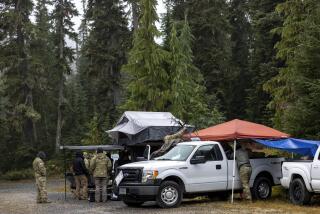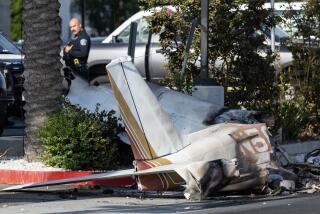Air collision rained debris on Norwalk
On a cloudless Saturday evening 50 years ago this week, a Navy bomber carrying eight reservists thundered on a routine training flight out of Los Alamitos Naval Air Station.
A minute later, less than 10 miles away, a four-engine Air Force transport plane took off from Long Beach Municipal Airport on its way to McGuire Air Force Base in New Jersey. It carried 35 passengers from various military branches and a crew of six.
Less than five minutes after they took off, about half a mile above Norwalk, the planes collided at 7:13 p.m. All but two onboard the planes perished, as did a woman on the ground.
The transport exploded in the air, the tail section slamming into a service station at Firestone and Pioneer boulevards. Another large flaming portion plummeted to the ground across the street, where it exploded in the parking lot of the Norwalk sheriff’s station, igniting fuel in an underground storage tank and damaging buildings and cars. Jail inmates, in a panic, screamed to be released, according to news accounts.
As debris fell, 25-year-old Edith Rachel Hernandez dashed out of her Jersey Avenue home to see what was happening -- after making sure her two children were safe inside. She was sliced in half by falling metal, Times reports said.
The two survivors were found at the crumpled fuselage of the bomber, which had plunged into a clay pit in Santa Fe Springs, more than a mile from the collision.
The Feb. 1, 1958 disaster, at the time labeled the worst in Southern California’s increasingly crowded skies, sparked a congressional probe and prompted the Navy to ban low-altitude flights from Los Alamitos over the metropolitan area. The cause soon was found to be mainly pilot error, a failure to follow the “see and avoid” mandate of visual flight rules.
The crash brought chilling reminders of another midair collision of military planes over a suburban neighborhood that had occurred a year earlier, when a fighter jet and military transport plane collided above Pacoima Junior High in the San Fernando Valley. That crash killed all five aboard the planes and three students on the playground and injured 70 other people.
The Norwalk collision, whose victims will be honored at a public memorial service Friday by military and city officials, turned quiet streets into scenes of horror and confusion and deeply affected survivors and those who witnessed the destruction.
The two survivors onboard the Navy plane were Leslie Van Dyke, an electronics technician, and aviation machinist Sanford Lee Fenton. Both men declined to talk to a reporter about their memories of the crash. Van Dyke, 73, a retired school administrator, said it was still too painful to discuss.
Shortly after the crash, however, he had described what happened to federal investigators and to reporters.
“Word came back to bail out,” Van Dyke said after the impact sent the crippled Lockheed P2V Neptune patrol bomber off course and into a steep dive. Everyone prepared to parachute but, realizing that the plane already was too low for a safe jump, decided to ride it out.
Seconds later, the Neptune crashed into the clay pit. Five of the eight aboard died on impact. Van Dyke was thrown about the plane. Dazed, he climbed out a large hole in the fuselage and scrambled up the side of the deep pit, where he ran up to a high, wire fence and yelled for help.
“He called to us, ‘Get my buddies out!’ ” reported a fire captain who had arrived at the crash site.
Nursing a broken ankle, cuts and bruises, Van Dyke watched firefighters cut through the wreckage and pull his pals out. One, Raymond Willard McCafferty, 21, died shortly after reaching the hospital. Fenton, who was critically injured, spent months recovering.
The catastrophe was witnessed by many drivers on the nearby 5 Freeway as well as by dozens of residents, many of whom were already outdoors scanning the sky for a glimpse of America’s first satellite, “Explorer 1.”
“I was a 10-year-old kid, standing outside with my family on Flatbush Avenue, waiting for the satellite to pass over, when this fireball erupted,” Terry Ramey, now 60 and living in Anaheim Hills, said in a recent interview. Ordered inside the house by his father because of the danger, he hesitated and watched pieces of the transport plane fall to the ground about three blocks away.
“I can see it as vividly today as I did then,” said Ramey, a former Navy pilot who owns a construction company.
Norwalk gas station attendant Raul Enlow was installing a headlight on a car across from the sheriff’s station when he got up to help a customer who had pulled in for gas, according to Times accounts. “That was the luckiest break for me that ever happened,” Enlow said. The garage and car he was working on were crushed. “The large tail section smashed, poom! right in the middle of the station,” said Enlow, who was thrown 20 feet by the explosion but only slightly injured.
Not far away, on Union Street, James Clark was fiddling with his TV set. “I was holding our infant daughter, adjusting the TV, when I heard a boom and then a whining,” Clark, now 73, said in a recent interview. “. . . part of the larger plane crashed a few blocks from our house. I took off running [toward the crash], holding my daughter. You don’t think clearly when those things happen, and my wife came running after me to take our daughter back home, away from the smoke and debris.
“Part of the plane was torn away, and I remember seeing a dead man strapped to his seat. It was an awful sight,” said Clark, a retired auto mechanic who lives in La Mirada.
The crash deepened public alarm. According to a Times editorial, “Tragedy in the Crowded Air,” the Civil Aeronautics Board, a precursor to the National Transportation Safety Board, found that in 1957, the year before the midair collision, “the air over Los Angeles was the scene of more near-collisions than any other city in the nation.”
Little remains of the crash sites today. The Santa Fe Springs clay pit is an industrial park.
In Norwalk, only a small commemorative plaque honoring the military victims, placed at the fateful intersection in 1964 by the American Legion, serves as a reminder of the fiery tragedy. The handful of houses that were damaged or destroyed have long since been replaced. A strip mall eventually succeeded the damaged sheriff’s station, which was rebuilt at a new Civic Center.
The gas station where Enlow narrowly escaped death gave way to a Goodwill store and parking lot.
It is there, at the intersection of Firestone and Pioneer, that Friday’s memorial service will begin at 10 a.m.
--
cecilia.rasmussen@ latimes.com
More to Read
Sign up for Essential California
The most important California stories and recommendations in your inbox every morning.
You may occasionally receive promotional content from the Los Angeles Times.










